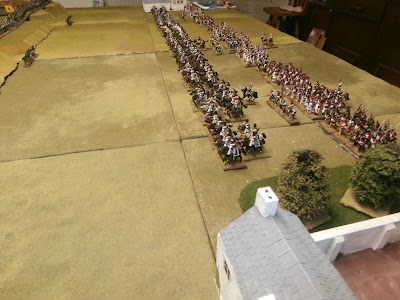The Scenario
This scenario featured a large, but low quality, Prussian force attacking the French Guards. We tweaked history slightly to allow Napoleon to allocate some Old guard in support of the Young's. A forgivable change and it did mean we got to see the old boys in action for once.
 |
| Plancenoite scenario |
The Battle
The French stood ready with the Young Guard on their left defending a ridge and the Old Guard occupying Plancenoite and the famous church. Skirmishers were thrown forward and a small reserve was in place.
 |
| The Young Guard |
 |
| The Old Guard |
A large Prussian force opposed them, comprising pretty-much every suitable figure we had. Some Dutch-Belgium's were fielded as Reserve units in British-supplied uniforms.
 |
| The Prussian left |
 |
| The Prussian right |
The Prussians deployed with their low-quality Reserve units to the front and their better Line or Old regiments in the rear. Mindful of how tough A+ troops are to evict from cover the Prussians planned an attritional approach using their larger numbers in a shooting war.
 |
| The French left |
On their left the French stood-too and engaged the Prussians in a fire-fight On their right though the French guards unexpectedly went on the offensive and pushed forward from the town
 |
| The Guard attacks |
 |
| Initial success for the Guard |
Initially the Guards bold gamble was a success as they pushed-back the Prussian Reserve units. As the night progressed though they became slowly weakened and in the end one unit as disordered an on the verge of breaking
 |
| The Guards under pressure |
On their left the French cavalry has the better of the melee but by the time they had defeated their enemy the Young Guard was severely depleted and on the verge of defeat. Even the appearance of the Cuirassiers on their flank was unlikely to hold the Prussians
 |
| Cavalry clash |
 |
| The French have the better of the day |
We halted after about 8 turns but by then the French were struggling. The Old Guard was largely a spent force and Plancenoite was flanked. On the right the Young Guard was struggling. The French could likely hold village as cover is tough to assault but it was surrounded.
Reflections
This was in fact the second time we played the scenario. In the first the Prussians launched a head-long attack with their best troops against the town and the ridge. The result was a rapid defeat as the Prussians simply bounced-off the town and streamed to the rear.
In our second attempt the Prussians were to rely on shooting instead as although the cover helps A+ die as easily as anyone else and eventually a fire might start that drive them out. The action was also heavily influenced by Lobau's decision to attack with the Guard.
It later emerged that an especially dull series of FOW games played over the weekend left him with a blood lust and a desire to close with the enemy in a way he'd been unable to with his early war German cavalry. As in real life its often about the psychology of the commanders can determine the outcome. Clearly the French had been on the receiving end of some Grow Mindset teaching - you can nt route the whole Prussian army.....yet!
The only point of debate on the rules was how to handle a unit forced to retreat through another. The unit interpenetrated suffered no penalty much to the chagrin of the Guards. We discussed perhaps B and C class troops being DISORDERED in such a situation.































